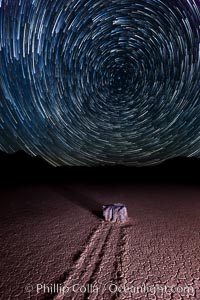
Racetrack sailing stone and star trails. A sliding rock of the Racetrack Playa. The sliding rocks, or sailing stones, move across the mud flats of the Racetrack Playa, leaving trails behind in the mud. The explanation for their movement is not known with certainty, but many believe wind pushes the rocks over wet and perhaps icy mud in winter.
Location: Racetrack Playa, Death Valley National Park, California
Image ID: 27671
Location: Racetrack Playa, Death Valley National Park, California
Image ID: 27671
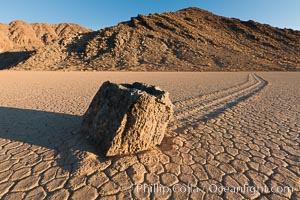
Sailing stone on the Racetrack Playa. The sliding rocks, or sailing stones, move across the mud flats of the Racetrack Playa, leaving trails behind in the mud. The explanation for their movement is not known with certainty, but many believe wind pushes the rocks over wet and perhaps icy mud in winter.
Location: Racetrack Playa, Death Valley National Park, California
Image ID: 27689
Location: Racetrack Playa, Death Valley National Park, California
Image ID: 27689
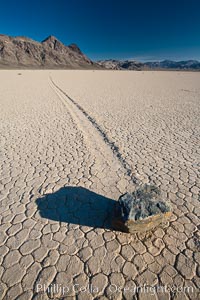
A sliding rock of the Racetrack Playa. The sliding rocks, or sailing stones, move across the mud flats of the Racetrack Playa, leaving trails behind in the mud. The explanation for their movement is not known with certainty, but many believe wind pushes the rocks over wet and perhaps icy mud in winter.
Location: Racetrack Playa, Death Valley National Park, California
Image ID: 25239
Location: Racetrack Playa, Death Valley National Park, California
Image ID: 25239
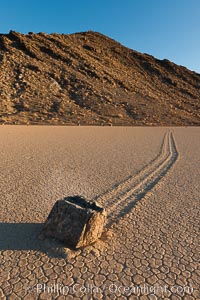
Sailing stone on the Racetrack Playa. The sliding rocks, or sailing stones, move across the mud flats of the Racetrack Playa, leaving trails behind in the mud. The explanation for their movement is not known with certainty, but many believe wind pushes the rocks over wet and perhaps icy mud in winter.
Location: Racetrack Playa, Death Valley National Park, California
Image ID: 27691
Location: Racetrack Playa, Death Valley National Park, California
Image ID: 27691
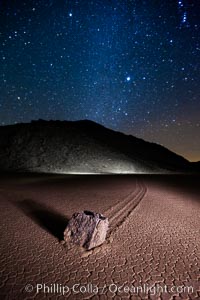
Racetrack sailing stone and Milky Way, at night. A sliding rock of the Racetrack Playa. The sliding rocks, or sailing stones, move across the mud flats of the Racetrack Playa, leaving trails behind in the mud. The explanation for their movement is not known with certainty, but many believe wind pushes the rocks over wet and perhaps icy mud in winter.
Location: Racetrack Playa, Death Valley National Park, California
Image ID: 27640
Location: Racetrack Playa, Death Valley National Park, California
Image ID: 27640
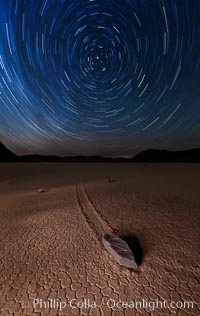
Racetrack sailing stone and star trails. A sliding rock of the Racetrack Playa. The sliding rocks, or sailing stones, move across the mud flats of the Racetrack Playa, leaving trails behind in the mud. The explanation for their movement is not known with certainty, but many believe wind pushes the rocks over wet and perhaps icy mud in winter.
Location: Racetrack Playa, Death Valley National Park, California
Image ID: 27667
Location: Racetrack Playa, Death Valley National Park, California
Image ID: 27667
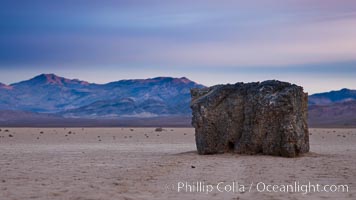
Sunrise on the Racetrack Playa. The sliding rocks, or sailing stones, move across the mud flats of the Racetrack Playa, leaving trails behind in the mud. The explanation for their movement is not known with certainty, but many believe wind pushes the rocks over wet and perhaps icy mud in winter.
Location: Racetrack Playa, Death Valley National Park, California
Image ID: 27701
Location: Racetrack Playa, Death Valley National Park, California
Image ID: 27701
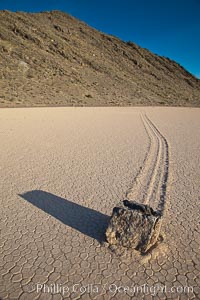
A sliding rock of the Racetrack Playa. The sliding rocks, or sailing stones, move across the mud flats of the Racetrack Playa, leaving trails behind in the mud. The explanation for their movement is not known with certainty, but many believe wind pushes the rocks over wet and perhaps icy mud in winter.
Location: Racetrack Playa, Death Valley National Park, California
Image ID: 25243
Location: Racetrack Playa, Death Valley National Park, California
Image ID: 25243
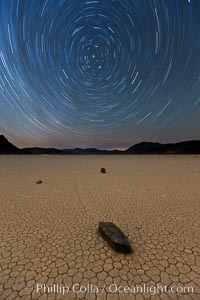
Racetrack sailing stone and star trails. A sliding rock of the Racetrack Playa. The sliding rocks, or sailing stones, move across the mud flats of the Racetrack Playa, leaving trails behind in the mud. The explanation for their movement is not known with certainty, but many believe wind pushes the rocks over wet and perhaps icy mud in winter.
Location: Racetrack Playa, Death Valley National Park, California
Image ID: 27668
Location: Racetrack Playa, Death Valley National Park, California
Image ID: 27668
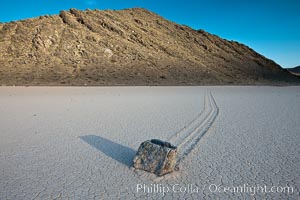
A sliding rock of the Racetrack Playa. The sliding rocks, or sailing stones, move across the mud flats of the Racetrack Playa, leaving trails behind in the mud. The explanation for their movement is not known with certainty, but many believe wind pushes the rocks over wet and perhaps icy mud in winter.
Location: Racetrack Playa, Death Valley National Park, California
Image ID: 25266
Location: Racetrack Playa, Death Valley National Park, California
Image ID: 25266
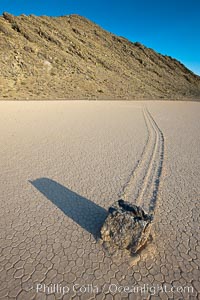
Sailing stone on the Death Valley Racetrack playa. The sliding rocks, or sailing stones, move across the mud flats of the Racetrack Playa, leaving trails behind in the mud. The explanation for their movement is not known with certainty, but many believe wind pushes the rocks over wet and perhaps icy mud in winter.
Location: Racetrack Playa, Death Valley National Park, California
Image ID: 25328
Location: Racetrack Playa, Death Valley National Park, California
Image ID: 25328
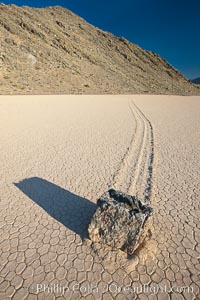
A sliding rock of the Racetrack Playa. The sliding rocks, or sailing stones, move across the mud flats of the Racetrack Playa, leaving trails behind in the mud. The explanation for their movement is not known with certainty, but many believe wind pushes the rocks over wet and perhaps icy mud in winter.
Location: Racetrack Playa, Death Valley National Park, California
Image ID: 25330
Location: Racetrack Playa, Death Valley National Park, California
Image ID: 25330
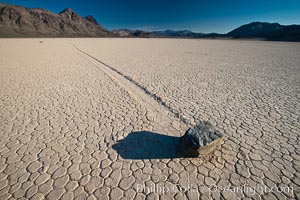
Sailing stone on the Death Valley Racetrack playa. The sliding rocks, or sailing stones, move across the mud flats of the Racetrack Playa, leaving trails behind in the mud. The explanation for their movement is not known with certainty, but many believe wind pushes the rocks over wet and perhaps icy mud in winter.
Location: Racetrack Playa, Death Valley National Park, California
Image ID: 25321
Location: Racetrack Playa, Death Valley National Park, California
Image ID: 25321
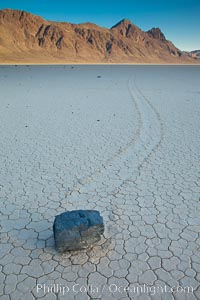
A sliding rock of the Racetrack Playa. The sliding rocks, or sailing stones, move across the mud flats of the Racetrack Playa, leaving trails behind in the mud. The explanation for their movement is not known with certainty, but many believe wind pushes the rocks over wet and perhaps icy mud in winter.
Location: Racetrack Playa, Death Valley National Park, California
Image ID: 25325
Location: Racetrack Playa, Death Valley National Park, California
Image ID: 25325
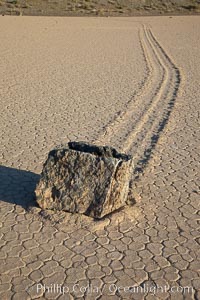
Sailing stone on the Death Valley Racetrack playa. The sliding rocks, or sailing stones, move across the mud flats of the Racetrack Playa, leaving trails behind in the mud. The explanation for their movement is not known with certainty, but many believe wind pushes the rocks over wet and perhaps icy mud in winter.
Location: Racetrack Playa, Death Valley National Park, California
Image ID: 25329
Location: Racetrack Playa, Death Valley National Park, California
Image ID: 25329
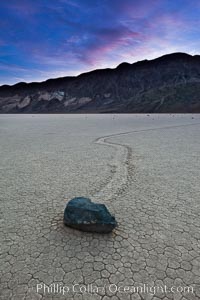
Sunrise on the Racetrack Playa. The sliding rocks, or sailing stones, move across the mud flats of the Racetrack Playa, leaving trails behind in the mud. The explanation for their movement is not known with certainty, but many believe wind pushes the rocks over wet and perhaps icy mud in winter.
Location: Racetrack Playa, Death Valley National Park, California
Image ID: 27699
Location: Racetrack Playa, Death Valley National Park, California
Image ID: 27699
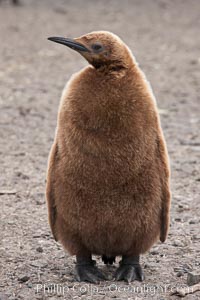
Oakum boys, juvenile king penguins at Salisbury Plain, South Georgia Island. Named 'oakum boys' by sailors for the resemblance of their brown fluffy plumage to the color of oakum used to caulk timbers on sailing ships, these year-old penguins will soon shed their fluffy brown plumage and adopt the colors of an adult.
Species: King penguin, Aptenodytes patagonicus
Location: Salisbury Plain, South Georgia Island
Image ID: 24405
Species: King penguin, Aptenodytes patagonicus
Location: Salisbury Plain, South Georgia Island
Image ID: 24405

Oakum boys, juvenile king penguins at Salisbury Plain, South Georgia Island. Named 'oakum boys' by sailors for the resemblance of their brown fluffy plumage to the color of oakum used to caulk timbers on sailing ships, these year-old penguins will soon shed their fluffy brown plumage and adopt the colors of an adult.
Species: King penguin, Aptenodytes patagonicus
Location: Salisbury Plain, South Georgia Island
Image ID: 24406
Species: King penguin, Aptenodytes patagonicus
Location: Salisbury Plain, South Georgia Island
Image ID: 24406
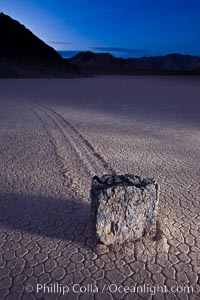
Sunrise on the Racetrack Playa. The sliding rocks, or sailing stones, move across the mud flats of the Racetrack Playa, leaving trails behind in the mud. The explanation for their movement is not known with certainty, but many believe wind pushes the rocks over wet and perhaps icy mud in winter.
Location: Racetrack Playa, Death Valley National Park, California
Image ID: 27696
Location: Racetrack Playa, Death Valley National Park, California
Image ID: 27696
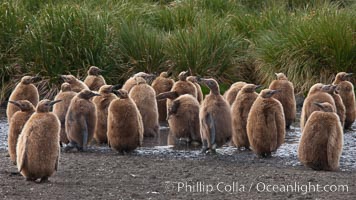
Oakum boys, juvenile king penguins at Salisbury Plain, South Georgia Island. Named 'oakum boys' by sailors for the resemblance of their brown fluffy plumage to the color of oakum used to caulk timbers on sailing ships, these year-old penguins will soon shed their fluffy brown plumage and adopt the colors of an adult.
Species: King penguin, Aptenodytes patagonicus
Location: Salisbury Plain, South Georgia Island
Image ID: 24408
Species: King penguin, Aptenodytes patagonicus
Location: Salisbury Plain, South Georgia Island
Image ID: 24408
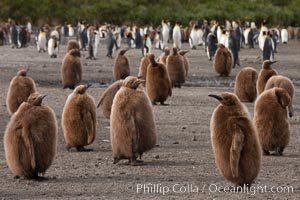
Oakum boys, juvenile king penguins at Salisbury Plain, South Georgia Island. Named 'oakum boys' by sailors for the resemblance of their brown fluffy plumage to the color of oakum used to caulk timbers on sailing ships, these year-old penguins will soon shed their fluffy brown plumage and adopt the colors of an adult.
Species: King penguin, Aptenodytes patagonicus
Location: Salisbury Plain, South Georgia Island
Image ID: 24455
Species: King penguin, Aptenodytes patagonicus
Location: Salisbury Plain, South Georgia Island
Image ID: 24455
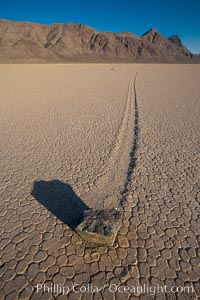
A sliding rock of the Racetrack Playa. The sliding rocks, or sailing stones, move across the mud flats of the Racetrack Playa, leaving trails behind in the mud. The explanation for their movement is not known with certainty, but many believe wind pushes the rocks over wet and perhaps icy mud in winter.
Location: Racetrack Playa, Death Valley National Park, California
Image ID: 25322
Location: Racetrack Playa, Death Valley National Park, California
Image ID: 25322
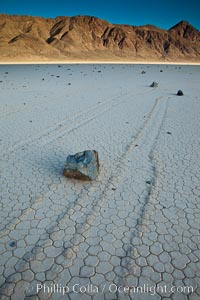
Sailing stone on the Death Valley Racetrack playa. The sliding rocks, or sailing stones, move across the mud flats of the Racetrack Playa, leaving trails behind in the mud. The explanation for their movement is not known with certainty, but many believe wind pushes the rocks over wet and perhaps icy mud in winter.
Location: Racetrack Playa, Death Valley National Park, California
Image ID: 25324
Location: Racetrack Playa, Death Valley National Park, California
Image ID: 25324
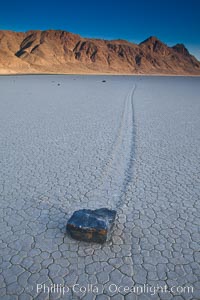
Sailing stone on the Death Valley Racetrack playa. The sliding rocks, or sailing stones, move across the mud flats of the Racetrack Playa, leaving trails behind in the mud. The explanation for their movement is not known with certainty, but many believe wind pushes the rocks over wet and perhaps icy mud in winter.
Location: Racetrack Playa, Death Valley National Park, California
Image ID: 25327
Location: Racetrack Playa, Death Valley National Park, California
Image ID: 25327
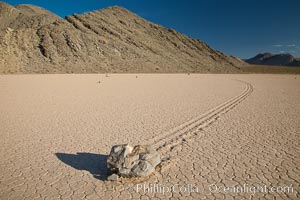
Sailing stone on the Death Valley Racetrack playa. The sliding rocks, or sailing stones, move across the mud flats of the Racetrack Playa, leaving trails behind in the mud. The explanation for their movement is not known with certainty, but many believe wind pushes the rocks over wet and perhaps icy mud in winter.
Location: Racetrack Playa, Death Valley National Park, California
Image ID: 25331
Location: Racetrack Playa, Death Valley National Park, California
Image ID: 25331
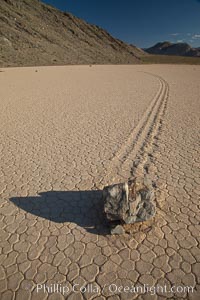
A sliding rock of the Racetrack Playa. The sliding rocks, or sailing stones, move across the mud flats of the Racetrack Playa, leaving trails behind in the mud. The explanation for their movement is not known with certainty, but many believe wind pushes the rocks over wet and perhaps icy mud in winter.
Location: Racetrack Playa, Death Valley National Park, California
Image ID: 25332
Location: Racetrack Playa, Death Valley National Park, California
Image ID: 25332
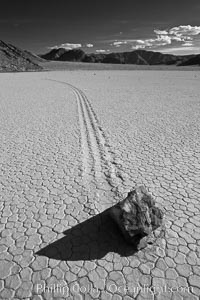
Sailing stone on the Death Valley Racetrack playa. The sliding rocks, or sailing stones, move across the mud flats of the Racetrack Playa, leaving trails behind in the mud. The explanation for their movement is not known with certainty, but many believe wind pushes the rocks over wet and perhaps icy mud in winter.
Location: Racetrack Playa, Death Valley National Park, California
Image ID: 25333
Location: Racetrack Playa, Death Valley National Park, California
Image ID: 25333
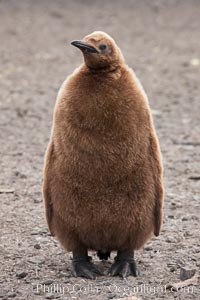
Oakum boys, juvenile king penguins at Salisbury Plain, South Georgia Island. Named 'oakum boys' by sailors for the resemblance of their brown fluffy plumage to the color of oakum used to caulk timbers on sailing ships, these year-old penguins will soon shed their fluffy brown plumage and adopt the colors of an adult.
Species: King penguin, Aptenodytes patagonicus
Location: Salisbury Plain, South Georgia Island
Image ID: 24534
Species: King penguin, Aptenodytes patagonicus
Location: Salisbury Plain, South Georgia Island
Image ID: 24534
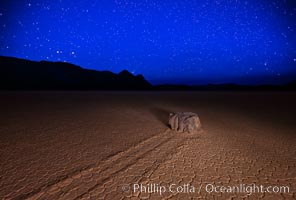
Racetrack sailing stone and stars at night. A sliding rock of the Racetrack Playa. The sliding rocks, or sailing stones, move across the mud flats of the Racetrack Playa, leaving trails behind in the mud. The explanation for their movement is not known with certainty, but many believe wind pushes the rocks over wet and perhaps icy mud in winter.
Location: Racetrack Playa, Death Valley National Park, California
Image ID: 27636
Location: Racetrack Playa, Death Valley National Park, California
Image ID: 27636
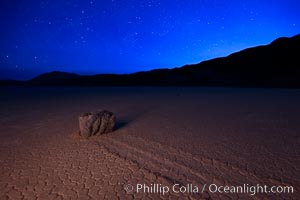
Racetrack sailing stone and stars at night. A sliding rock of the Racetrack Playa. The sliding rocks, or sailing stones, move across the mud flats of the Racetrack Playa, leaving trails behind in the mud. The explanation for their movement is not known with certainty, but many believe wind pushes the rocks over wet and perhaps icy mud in winter.
Location: Racetrack Playa, Death Valley National Park, California
Image ID: 27637
Location: Racetrack Playa, Death Valley National Park, California
Image ID: 27637